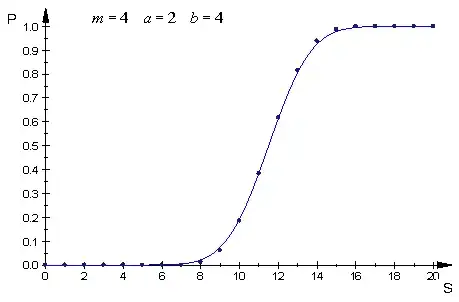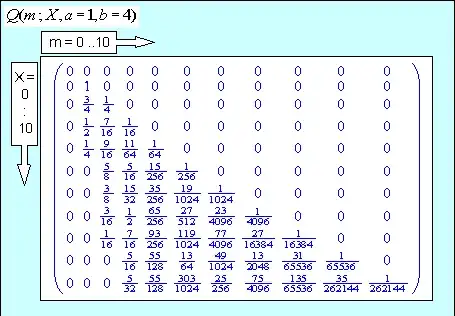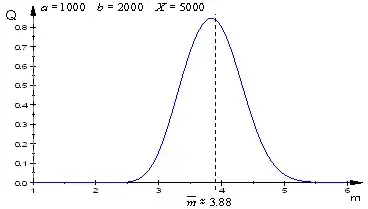Given $m$ discrete variables in the range $[a,b]$, the number of ways to get a sum $s$ out of them corresponds to
$$
\eqalign{
& N_b (s - ma,d,m) = \cr
& = {\rm No}{\rm .}\,{\rm of}\,{\rm solutions}\,{\rm to}\;\left\{ \matrix{
a \le {\rm integer}\;y_{\,j} \le b \hfill \cr
y_{\,1} + y_{\,2} + \; \cdots \; + y_{\,m} = s \hfill \cr} \right.\quad = \cr
& = {\rm No}{\rm .}\,{\rm of}\,{\rm solutions}\,{\rm to}\;\left\{ \matrix{
{\rm 0} \le {\rm integer}\;x_{\,j} \le b - a = d \hfill \cr
x_{\,1} + x_{\,2} + \; \cdots \; + x_{\,m} = s - ma \hfill \cr} \right. \cr}
$$
where $N_b$ is given by
$$ \bbox[lightyellow] {
N_b (s-ma,d,m)\quad \left| {\;0 \leqslant \text{integers }s,m,d} \right.\quad =
\sum\limits_{\left( {0\, \leqslant } \right)\,\,k\,\,\left( { \leqslant \,\frac{s-ma}{d+1}\, \leqslant \,m} \right)}
{\left( { - 1} \right)^k \binom{m}{k}
\binom
{ s -ma+ m - 1 - k\left( {d + 1} \right) }
{ s-ma - k\left( {d + 1} \right)}\ }
} \tag{1} $$
as widely explained in this post.
Let's also notice the symmetry property of $N_b$
$$
N_b (s - ma,d,m) = N_b (md - \left( {s - ma} \right),d,m) = N_b (mb - s,d,m)
$$
The probability of obtaining exactly the sum $s$ in $m$ rolls is therefore
$$ \bbox[lightyellow] {
\eqalign{
& p(s\;;\,m,a,b) = {{N_b (s - ma,d,m)} \over {\left( {d + 1} \right)^{\,m} }} = {{N_b (mb - s,d,m)} \over {\left( {d + 1} \right)^{\,m} }} = \cr
& = {1 \over {\left( {d + 1} \right)^{\,m} }}
\sum\limits_{\left( {0\, \le } \right)\,\,k\,\,\left( { \le \,{{s - ma} \over {d + 1}}\, \le \,m} \right)} {
\left( { - 1} \right)^k \binom{m}{k}
\binom{ s -ma+ m - 1 - k\left( {d + 1} \right) }{ s-ma - k\left( {d + 1} \right)} } = \cr
& = {1 \over {\left( {d + 1} \right)^{\,m} }}
\sum\limits_{\left( {0\, \le } \right)\,\,k\,\,\left( { \le \,{{mb - s} \over {d + 1}}\, \le \,m} \right)} {
\left( { - 1} \right)^k \binom{m}{k}
\binom{ mb-s+ m - 1 - k\left( {d + 1} \right) }{ mb-s - k\left( {d + 1} \right)} } \cr}
} \tag{2} $$
and the sum of $p$ over $s$ is in fact one.
The probability $p$ quickly converges, by Central Limit Theorem, to the Gaussian in the variable $s$
$$
\cal N\left( {\mu ,\sigma ^{\,2} } \right)\quad \left| \matrix{
\;\mu = m\left( {{d \over 2} + a} \right) = m\left( {{{a + b} \over 2}} \right) \hfill \cr
\;\sigma ^{\,2} = m{{\left( {d + 1} \right)^{\,2} - 1} \over {12}} \hfill \cr} \right.
$$
see for instance this post.
It is easy to demonstrate (by the "double convoluton" of binomials) that the Cumulative version, i.e. the probability to obtain a sum $\le S$, is
$$ \bbox[lightyellow] {
\eqalign{
& P(S\;;\,m,a,b) = {1 \over {\left( {d + 1} \right)^{\,m} }}\sum\limits_{0\, \le \,\,s\,\, \le \,S} {N_b (s - ma,d,m)} = \cr
& = {1 \over {\left( {d + 1} \right)^{\,m} }}\sum\limits_{\left( {0\, \le } \right)\,\,k\,\,\left( { \le \,{{s - ma} \over {d + 1}}\, \le \,m} \right)} {
\left( { - 1} \right)^k \binom{m}{k}
\binom{S - ma + m - k\left( {d + 1} \right) }{S - ma - k\left( {d + 1} \right) } } \cr
& \approx {1 \over 2}\left( {1 + {\rm erf}\left( {\sqrt 6 {{S + 1/2 - m\left( {a + b} \right)/2} \over {\left( {b - a + 1} \right)\sqrt m \;}}} \right)} \right) \cr}
} \tag{3} $$
The following plot allows to appreciate the good approximation provided by the asymptotics
even at relatively small values of the parameters involved.

That premised,
the probability that we reach or exceed a predefined sum $X$ at the $m$-th roll and not earlier
is given by the probability that
we get $S<X$ as the sum of the first $m-1$ rolls, and then that the $m$-th one has a value $s$ such that $X \le S+s$,
or, what is demonstrably the same, by
the probability of getting $X \le S$ in $m$ rolls minus the probability of getting the same in $m-1$ rolls.
That is, in conclusion
$$ \bbox[lightyellow] {
\eqalign{
& Q(m\;;\,X,a,b)\quad \left| \matrix{
\;1 \le m \hfill \cr
\;0 \le X \hfill \cr
\;0 \le a \le b \hfill \cr} \right.\quad = \cr
& = 1 - P(X - 1\;;\,m,a,b) - 1 + P(X - 1\;;\,m - 1,a,b) = \cr
& = P(X - 1\;;\,m - 1,a,b) - P(X - 1\;;\,m,a,b) \cr}
} \tag{4} $$
and the sum of $Q$ over $m$ correctly checks to one.
Example
a) For small values of $X,a,b$ the exact expression for $Q$ in (4) gives the results shown (e.g. $a=1, \; b=4$)
which look to be correct and the row sums correctly check to be $1$.

b) For large values of the parameters, like in your example $a=1000,\; b=2000, \; X=5000$
we shall use the asymptotic version of $Q$ which gives the results plotted below



